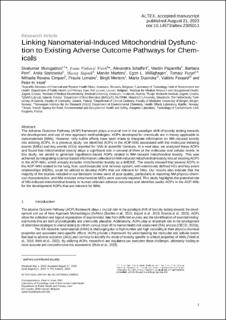Linking Nanomaterial-Induced Mitochondrial Dysfunction to Existing Adverse Outcome Pathways for Chemicals
| dc.contributor.author | Murugadoss, Sivakumar | |
| dc.contributor.author | Vrček, Ivana Vinković | |
| dc.contributor.author | Schaffert, Alexandra | |
| dc.contributor.author | Paparella, Martin | |
| dc.contributor.author | Pem, Barbara | |
| dc.contributor.author | Sosnowska, Anita | |
| dc.contributor.author | Stępnik, Maciej | |
| dc.contributor.author | Martens, Marvin | |
| dc.contributor.author | Willighagen, Egon L. | |
| dc.contributor.author | Puzyn, Tomasz | |
| dc.contributor.author | Cimpan, Mihaela-Roxana | |
| dc.contributor.author | Lemaire, Frauke | |
| dc.contributor.author | Mertens, Birgit | |
| dc.contributor.author | Dusinska, Maria | |
| dc.contributor.author | Fessard, Valérie | |
| dc.contributor.author | Hoet, Peter H. | |
| dc.date.accessioned | 2023-11-21T15:34:38Z | |
| dc.date.available | 2023-11-21T15:34:38Z | |
| dc.date.created | 2023-09-28T15:50:22Z | |
| dc.date.issued | 2023 | |
| dc.identifier.citation | Altex. 2023. | en_US |
| dc.identifier.issn | 1868-596X | |
| dc.identifier.uri | https://hdl.handle.net/11250/3103925 | |
| dc.description.abstract | The Adverse Outcome Pathway (AOP) framework plays a crucial role in the paradigm shift of toxicity testing towards the development and use of new approach methodologies. AOPs developed for chemicals are in theory applicable to nanomaterials (NMs). However, only subtle efforts have been made to integrate information on NM-induced toxicity into existing AOPs. In a previous study, we identified AOPs in the AOP-Wiki associated with the molecular initiating events (MIEs) and key events (KEs) reported for NMs in scientific literature. In a next step, we analyzed these AOPs and found that mitochondrial toxicity plays a significant role in several of them at the molecular and cellular levels. In this study, we aimed to generate hypothesis-based AOPs related to NM-induced mitochondrial toxicity. This was achieved by integrating science-based information collected on NM-induced mitochondrial toxicity into all existing AOPs in the AOP-Wiki, which already includes mitochondrial toxicity as a MIE/KE. The results showed that several AOPs in the AOP-Wiki related to the lung, liver, cardiovascular and nervous system, with extensively defined KEs and key event relationships (KERs), could be utilized to develop AOPs that are relevant for NMs. Our results also indicate that the majority of the studies included in our literature review were of poor quality, particularly in reporting NM physico-chemical characteristics, and NM-relevant mitochondrial MIEs were scarcely reported. This study highlights the potential role of NM-induced mitochondrial toxicity in human-relevant adverse outcomes and identifies useful AOPs in the AOP-Wiki for the development AOPs that are relevant for NMs. | en_US |
| dc.language.iso | eng | en_US |
| dc.rights | Navngivelse 4.0 Internasjonal | * |
| dc.rights.uri | http://creativecommons.org/licenses/by/4.0/deed.no | * |
| dc.title | Linking Nanomaterial-Induced Mitochondrial Dysfunction to Existing Adverse Outcome Pathways for Chemicals | en_US |
| dc.title.alternative | Linking Nanomaterial-Induced Mitochondrial Dysfunction to Existing Adverse Outcome Pathways for Chemicals | en_US |
| dc.type | Peer reviewed | en_US |
| dc.type | Journal article | en_US |
| dc.description.version | publishedVersion | en_US |
| dc.rights.holder | © The Authors, 2023. | en_US |
| dc.source.journal | Altex | en_US |
| dc.identifier.doi | 10.14573/altex.2305011 | |
| dc.identifier.cristin | 2179993 | |
| dc.relation.project | Norges forskningsråd: 288768 | en_US |
| dc.relation.project | EC/H2020/101037090 | en_US |
| dc.relation.project | EC/H2020/814572 | en_US |
| dc.relation.project | EC/H2020/814425 | en_US |
| dc.relation.project | NILU: 119011 | en_US |
| cristin.ispublished | true | |
| cristin.fulltext | original | |
| cristin.qualitycode | 1 |
Tilhørende fil(er)
Denne innførselen finnes i følgende samling(er)
-
Publikasjoner fra Cristin - NILU [1343]
-
Vitenskapelige publikasjoner [1082]
Vitenskapelige artikler, kapitler og monografier.


